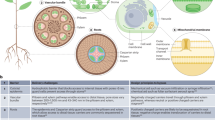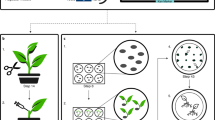Abstract
Factors influencing the efficiency of DNA delivery into suspension culture cells of Zea mays by the particle bombardment process were studied using a chimeric gene coding for the production of β–glucuronidase. Two days following bombardment with plasmid–coated microprojectiles, expression of the β–glucuronidase gene was detected with the synthetic substrate 5–bromo–4–chloro–3–indoyl–β–D–glucuronic acid, which, upon cleavage, forms a blue precipitate visually detectable within affected cells. The number of cells expressing β–glucuronidase was about 30 times greater when the cells were bombarded on a filter paper support than when they were bombarded while covered by liquid media without such a support. The efficiency of gene delivery was also significantly affected by the velocity of the microprojectile and the number of micro–projectiles used for bombardment, and the concentration of CaCl2 and spermidine used to adsorb DNA to the microprojectiles. In addition to cell cultures, the particle bombardment process was also used to deliver the β–glucuronidase gene to intact cells on the surface of excised Z. mays embryos. The results indicate that delivery by high–velocity microprojectiles may be useful for the stable transformation of monocot species.
This is a preview of subscription content, access via your institution
Access options
Subscribe to this journal
Receive 12 print issues and online access
$209.00 per year
only $17.42 per issue
Buy this article
- Purchase on Springer Link
- Instant access to full article PDF
Prices may be subject to local taxes which are calculated during checkout
Similar content being viewed by others
References
Fromm, M.E., Taylor, L.P., and Walbot, V. 1986. Stable transformation of maize after gene transfer by electroporation. Nature 319:719–793.
Lörz, H., Baker, B., and Schell, J. 1985. Gene transfer to cereal cells mediated by protoplast transformation. Molec. Gen. Genet. 199:178–182.
Fraley, R.T., Dellaporta, S.L., and Papahadjopoulos, D. 1982. Liposome-mediated delivery of tobacco mosaic virus RNA into tobacco protoplasts: a sensitive assay for monitoring liposome-protoplast interactions. Proc. Natl. Acad. Sci. USA 79:1859–1863.
Crossway, A., Oakes, J.V., Irvine, J.M., Ward, B., Knauf, V.C., and Shewmaker, C.K. 1985. Integration of foreign DNA following micro-injection of tobacco mesophyll protoplasts. Mol. Gen. Genet. 202:179–185.
Abdullah, R., Cocking, E.C., and Thompson, J.A. 1986. Efficient plant regeneration from rice protoplasts through somatic embryogenesis. Bio/Technology 4:1087–1090.
Fujimura, T., Sakurai, M., Akagi, H., Negishi, T., and Hirose, A. 1985. Regeneration of rice plants from protoplasts. Plant Tissue Cult. Lett 2:74–75.
Rhodes, C.A., Lowe, K.S., and Ruby, K.L. 1988. Plant regeneration from protoplasts isolated from embryogenic maize cell cultures. Bio/Technology 6:56–60.
Grimsley, N., Hohn, T., Davies, J.W. and Hohn, B. 1987. Agrobacterium-mediated delivery of infectious maize streak virus into maize plants. Nature 325:177–179.
Brisson, N., and Hohn, T. 1986. Plant virus vectors:cauliflower mosaic virus. Methods in Enzymol. 118:659–668.
Klein, T.M., Wolf, E.D., Wu, R., and Sanford, J.C. 1987. High-velocity microprojectiles for delivering nucleic acids into living cells. Nature 327:70–73.
Sanford, J.C., Klein, T.M., Wolf, E.D., and Allen, N. 1987. Delivery of substances into cells and tissues using a particle bombardment process. Particulate Sci. Technol. 5:27–37.
Johnston, S.A., Anziano, P., Shark, K.B., Sanford, J.C., and Butow, R.A. 1988. Transformation of yeast mitochondria by bombardment of cells with microprojectiles. Science, submitted.
Boynton, J.E., Gillham, N.W., Harris, E.H., Hosler, J.P., Johnson, A.M., Jones, A.R., Randolph-Anderson, B.L., Robertson, D., Klein, T.M., Shark, K.B., and Sanford, J.C. 1988. Chloroplast transformation in Chlamydomonas using high-velocity microprojectiles. Science, submitted.
Klein, T.M., Fromm, M.E., Weissinger, A., Tomes, D., Schaaf, S., Sletten, M., and Sanford, J.C. 1988. Transfer of foreign genes into intact maize cells using high-velocity microprojectiles. Proc. Natl. Acad. Sci. USA, in press.
Jefferson, R.A., Burgess, S.M., and Hirsh, D. 1986. β-Glucuronidase from Eschrichia coli as a gene-fusion marker. Proc. Natl. Acad. Sci. USA 83:8447–8451.
Jefferson, R.A., Kavanagh, T.A., and Bevan, M.W. 1987. GUS fusions: β-glucuronidase as a sensitive and versatile gene fusion marker in higher plants. EMBO J. 6:3901–3907.
Armstrong, C.L., and Green, C.E. 1985. Establishment and maintenance of friable, embryogenic maize callus and the involvement of L-proline. Planta 164:207–214.
Callis, J., Fromm, M.E., and Walbot, V. 1987. Introns increase chimeric gene expression in maize. Genes and Development 1:1183–1200.
Murashige, T. and Skoog, F. 1962. A revised medium for rapid growth and bioassays with tobacco tissue cultures. Physiol. Plant. 15:473–497.
Gamborg, O.L., Miller, R.A., and Ojima, K. 1968. Nutrient requirements of a suspension culture of soybean root cells. Exp. Cell Res. 50:151–158.
Chu, C.C., Wang, C.C., Sun, C.S., Hus, C., Yin, K.C., and Chu, C.Y. 1975. Establishment of an efficient medium for anther culture of rice through comparative experiments on the nitrogen source. Sci. Sin. 18:659–668.
Author information
Authors and Affiliations
Rights and permissions
About this article
Cite this article
Klein, T., Gradziel, T., Fromm, M. et al. Factors Influencing Gene Delivery into Zea Mays Cells by High–Velocity Microprojectiles. Nat Biotechnol 6, 559–563 (1988). https://doi.org/10.1038/nbt0588-559
Received:
Accepted:
Issue Date:
DOI: https://doi.org/10.1038/nbt0588-559
This article is cited by
-
Improved Agrobacterium-mediated transformation of Carica papaya cultivar ‘Kapoho’ from embryogenic cell suspension cultures
In Vitro Cellular & Developmental Biology - Plant (2015)
-
Classification of EA1-box proteins and new insights into their role during reproduction in grasses
Plant Reproduction (2015)
-
Optimization of factors influencing microprojectile bombardment-mediated genetic transformation of seed-derived callus and regeneration of transgenic plants in Eleusine coracana (L.) Gaertn
Plant Cell, Tissue and Organ Culture (PCTOC) (2012)
-
Problems and possibilities of monocot transformation
Biologia plantarum (2011)



